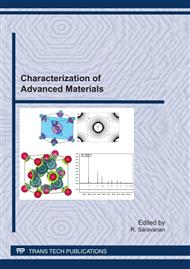[1]
Haijun Lian: Isotope effects on fundamental bandgap of lead sulphide, (2005).
Google Scholar
[2]
A. Elshafie, M.M. Elzaidia, H.H. Afify, M.H. Khalil, in: Electrical and optical properties of Lead sulfide thin films, Proc 2nd Saudi. Sci. Comf, Fac. Sci. KAU, 15-17, pp.251-265, (2004).
Google Scholar
[3]
D.E. Blackwell, G.B.B.M. Sutherland, P.B. Fellgett, in: Nature , Vol 158 (1946), pp.873-874.
Google Scholar
[4]
N. Choudry, B.K. Sarma, in: Structural charecterisation of Lead sulphide thin films by means of X-ray line profile analysis, Bull. Mater. Sci, Vol 32, pp.43-47, (2009).
DOI: 10.1007/s12034-009-0007-y
Google Scholar
[5]
Information on http: /kolkatamirror. com/index. aspx?page=article§id= 42&contentid= 2010032220100322172625864ad935a6f§xslt=.
Google Scholar
[6]
H.M. Rietveld: J. Appl. Crystallogr. 2, (1969) 65.
Google Scholar
[7]
JANA, in:V. Petricek, M. Dusek, L. Palatinus (Eds), in: The crystallographic Computing System, Institute of Physics, Academy of Sciences of the Czech Republic, Praha, (2000).
Google Scholar
[8]
M. Collins: Nature 298, 49, (1982).
Google Scholar
[9]
Izumi Fujio, A.D. Ruben. Dilanien, Super fast program, PRIMA, for the maximum entropy method from X-ray and Neutron Diffraction data, Advanced Materials Laboratory, National Institute for Materials Science, Japan, (2004), pp.305-0044.
Google Scholar
[10]
K. Momma, F. Izumi: J: Appl. Crystallogr. 41 (2008) 653.
Google Scholar
[11]
I.K. Jeong, J. Thompson, TH. Proffen, A. Perez, S.J.L. Billinge, PDFGetX, A Program for obtaining Atomic Pair Distribution Function from X-Ray Powder diffraction Data, (2001).
DOI: 10.1107/s0021889801009207
Google Scholar
[12]
C.L. Farrow, P. Juhas, J.W. Liu, D. Bryndin, E.S. Bozin, J. Bloch, Th. Proffen, S.J.L. Billiange, PDFFit and PDFgui;J. Phy. Condens. Mater vol. 19, p.335219, (2007).
DOI: 10.1088/0953-8984/19/33/335219
Google Scholar
[13]
Jean Laugier et Bernard Bochu: GRETEP, Domaine univeritaire BP 46, 38402 Saint Martind Heres , http: /www. inpg. fr/LMGP.
Google Scholar
[14]
R. Saravanan: GRAIN software available at http: /www. saraxraygroup. net.
Google Scholar
[15]
Information on http: / www. siliconfreast. com/edxwdx. htm.
Google Scholar
[16]
M. Navaneethan, K.D. Nisha,S. Ponnusamy,C. Muthamizhselvan, in: Rev. Adv. Mater. Sci, Vol 21, (2009), pp.217-224.
Google Scholar
[17]
N. Choudry, B.K. Sarma, in: Structural charecterisation of Lead sulphide thin films by means of X-ray line profile analysis, Bull. Mater. Sci, Vol 32, pp.43-47, (2009).
DOI: 10.1007/s12034-009-0007-y
Google Scholar
[18]
R. Saravanan, T.K. Yhirumalaisamy, in: J. Mater Sci: Mater Electron, 339, (2011).
Google Scholar
[19]
D.L. Wood, J. Tauc, Phys. Rev. B5, 3144, (1972).
Google Scholar
[20]
K. Suresh Babu, C. Vijayan, R. Devanathan, in: Elsevier B. V, (2003).
Google Scholar
[21]
Won young Lee, Rok Lee, Robert Sinclair, Fritz B Prinz, in: Nanotechnology, Vol21, (2010).
Google Scholar
[22]
Yu Zhao, Xue-Hong Liao, Jian-Min Hong, Jun-Jie Zhu, in: Materials Chemistry and Physics, Vol87, pp.149-153, (2004).
Google Scholar


